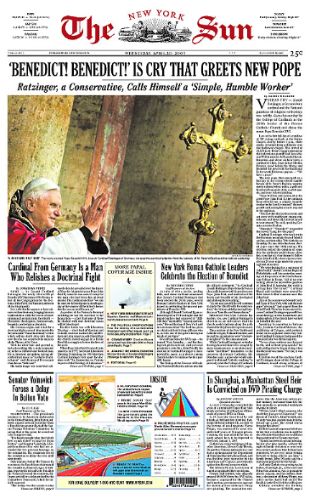Newspapers
About Andrew Cusack
 Writer, web designer, etc.; born in New York; educated in Argentina, Scotland, and South Africa; now based in London.
Writer, web designer, etc.; born in New York; educated in Argentina, Scotland, and South Africa; now based in London. read more
News
Blogs
Reviews & Periodicals
Arts & Design
World
France
Mitteleuropa
Knickerbockers
Argentina
The Levant
Africa
Cape of Good Hope
Netherlands
Scandinavia
Québec
India
Muscovy
Germany
Academica
Herald-Tribune Drops Iconic ‘Dingbat’
Famous Emblem from 1886 is Dropped in Move to ‘Modernize’
 The International Herald Tribune has unceremoniously dumped its unique 142-year-old nameplate logo, affectionately known as the “dingbat”. The graphic made its first appearance in the New York Tribune on April 10, 1866. The Tribune later merged with the New York Herald to become the New York Herald Tribune. The Herald had previously founded a separate European edition based in Paris. While the New York newspaper died in 1967, its weekly New York supplement survives as New York magazine and the Paris edition became the International Herald Tribune, jointly owned by the Whitney family and the New York Times. The Whitneys sold their stake to the Washington Post, which in turn ran the paper in alliance with the Times until 2002, when the New York Times Company became the sole proprietor of the IHT.
The International Herald Tribune has unceremoniously dumped its unique 142-year-old nameplate logo, affectionately known as the “dingbat”. The graphic made its first appearance in the New York Tribune on April 10, 1866. The Tribune later merged with the New York Herald to become the New York Herald Tribune. The Herald had previously founded a separate European edition based in Paris. While the New York newspaper died in 1967, its weekly New York supplement survives as New York magazine and the Paris edition became the International Herald Tribune, jointly owned by the Whitney family and the New York Times. The Whitneys sold their stake to the Washington Post, which in turn ran the paper in alliance with the Times until 2002, when the New York Times Company became the sole proprietor of the IHT.
The Paris-based newspaper’s executive editor Michael Oreskes said he hoped that dropping the dingbat would make the front page “cleaner, more modern, more streamlined”. Vanessa Whittall, the Herald Tribune‘s communications manager, meanwhile said “by removing the traditional ‘dingbat’ graphic between Herald and Tribune we have created a more contemporary and concise presentation that is consistent with our digital platforms.”
The New York Times Company has been beset with problems in recent years, with both profits and circulation falling; one Manhattan outlet reported seeing an 80% drop in sales of the Sunday New York Times. Shareholders have claimed that the general downturn for newspapers has only been exacerbated by Arthur Ochs Sulzberger, Jr.’s poor management. The decline of the Times has been mirrored in the IHT, which it now markets as its international edition.
Under the Times‘s control, the IHT has been seen to become more of a newspaper for Americans abroad than an American newspaper for an international audience. The blogger of “Think!: The blog for readers of the International Herald Tribune” questioned the prominence the paper devotes to American stories: “How a piece about baseball in the Netherlands (where I lived for three years) got more play directly next to an article about a cyclone in Burma that has killed around 100,000 people is a little hard to follow.”

Above, the traditional nameplate. Below, the ‘modern, streamlined’ nameplate.

The decision to remove the dingbat certainly has its critics. Juan Antonio Giner, the founder of a media consulting group and blogger at Innovationsinnewspapers said the move was “not a big revolution or a smart strategic decision for a dying newspaper”. Mr. Giner compared the management’s decision to “play with such a traditional, magnificent, beautiful, well-done logo” as “like moving the chairs on a sinking Titanic”.

The original dingbat, above, with the most recent incarnation below.

In “The Paper: The Life and Death of The New York Herald Tribune”, the definitive history of the deceased journal, Richard Kluger described the dingbat:
“in the middle of the crudely drawn tableau is a clock reading twelve minutes past six – no one knows why (conceivably it was the moment of Horace Greeley’s birth); to the left, Father Time sits in brooding contemplation of antiquity, represented by the ruin of a Greek temple, a man and his ox plowing, a caravan of six camels passing before two pyramids, and an hourglass; to the right, a sort of Americanized Joan of Arc, arms outstretched beneath a backwards-billowing Old Glory, welcomes modernity in the form of a chugging railroad train, factories with smoking chimneys, an updated plow, and an industrial cogwheel (over which the incautious heroine is about to trip); atop the clock, ready to take off into the boundless American future, is an eagle – all for no extra cost.”
“It was a baroque snapshot of time arrested,” Mr. Kluger continued, “an allegorical hieroglyph of the newspaper’s function to render history on the run”.
The deputy managing editor Robert Marino said of the dingbat, “I’m kind of sorry to see it go, but that’s progress.” Many of the Herald Tribune‘s readers will remain unconvinced.
You call this journalism?
The decline of the British newspaper, continued
THE DAILY TELEGRAPH is asking its readers to believe that Gordon Brown is going to repeal the Act of Settlement barring Catholics from the throne and that furthermore this would make Franz, Duke of Bavaria the heir to the throne of England (c.f. “Act repeal could make Franz Herzog von Bayern new King of England and Scotland”, by Richard Alleyne and Harry de Quetteville, Daily Telegraph, 7 April 2008). In reality, the British Parliament does not have the authority to unilaterally repeal the Act, since by convention it must consult with the sixteen commonwealth realms. (Hence why Edward VIII had only the options of either dumping Wallis Simpson or giving up the throne; London had consulted the dominion governments and they said they would not accept Mrs. Simpson as Queen, end of story). Thus Gordon Brown would actually need to consult with and receive unanimous approval from the governments of Antigua and Barbuda, Australia, the Bahamas, Barbados, Belize, Canada, Granada, Jamaica, New Zealand, Papua New Guinea, St. Kitts and Nevis, Saint Lucia, Saint Vincent and the Grenadines, the Solomon Islands, and Tuvalu, in addition to that of the United Kingdom.
Why, then, does the Daily Telegraph neglect to point out this necessity, seemingly obvious to anyone with more than a passing knowledge of the British constitution? Was the newspaper simply ignorant about the subject? If so, why did they choose to print an article about it without seeking further information from the plethora of readily-available sources? Or perhaps the newspaper did know but decided to ignore it in the interests of sensationalism? Either way, the proof is in the pudding: standards at the Daily Telegraph are not what they used to be.
Sloppy Journalism at the National Catholic Register
Not long ago I signed up for a trial subscription to the National Catholic Register, and while it certainly exceeds the other national Catholic newspapers on presentation, it lacks the weight of the Wanderer. A quick glance in the October 28, 2007 edition makes this clear. I speak, namely, of the article “Knights Templar: More Than the Stuff of Fiction”. The article points out that the Order of the Knights Templar was “founded in Jerusalem in 1118 to protect Christian pilgrims and defend the Christian presence in the Holy Land. … It was suppressed by Pope Clement V in 1312, following accusation of heresy against its members, and subsequently became the focus of legends and mysteries, most recently the outrageously inaccurate Da Vinci Code by Dan Brown.” The article then mentioned the recent rediscovery in the Vatican Archives of a document relating to the Knights Templar. All fair enough, up to now.
The Register‘s correspondent “spoke last month in Rome with Patrick Rae, a former brigadier general in the U.S. Army Reserve who serves as Grand Commander of the Knights Templar.” Huh? What? Was it not just stated that the Knights Templar were suppressed by Pope Clement V in 1312? The Register offers no help in explaining this discrepancy to us. General Rae, however, later informs us that the Knights Templar “reconstituted as a French order under Napoleon and from that day until today it has existed, an unbroken string”. This is rather mixing fact and fiction.
1) The Knights Templar no longer exist. They were suppressed by the Pope in the fourteenth century and not revived.
2) The group of which Patrick Rae is Grand Commander is an organization called the “Ordo Supremus Militaris Templi Hierosolymitani” (OSMTH) also known by its English name of the “Sovereign Military Order of the Temple of Jerusalem” (SMOTJ). It is neither sovereign, nor is it an order, but is instead a Christian ecumenical aid organization which styles itself an order.
3) There are dozens, if not hundreds, of groups going around calling themselves the Order of Knights Templar. In actual fact, they are not orders (they are merely ordinary associations, like a chess club or your friendly local circle of stamp-collectors) and they are not Templar (since the Templars no longer exist).
It is beyond me why the Register‘s correspondent chose to speak with the head of this particular Templar-style group out of the hundreds of Templar-style groups. Perhaps the correspondent was impressed by the UN’s recognition of the OSMTH with special consultative status. This status has also been granted to many other groups, such as the Rotary Club of Kathmandu, the Tunisian Mothers Association, and the Boy Scouts of America. But the reporter makes no real attempt to point out that the Knights Templar in question are not, in fact, the Knights Templar (which, again, no longer exist). Whether he is disingenuous or merely ignorant is up to question (in a spirit of Christian charity, let us assume the latter). However there can be no question that this is simply sloppy journalism.
Bring Back the Broadsheet!
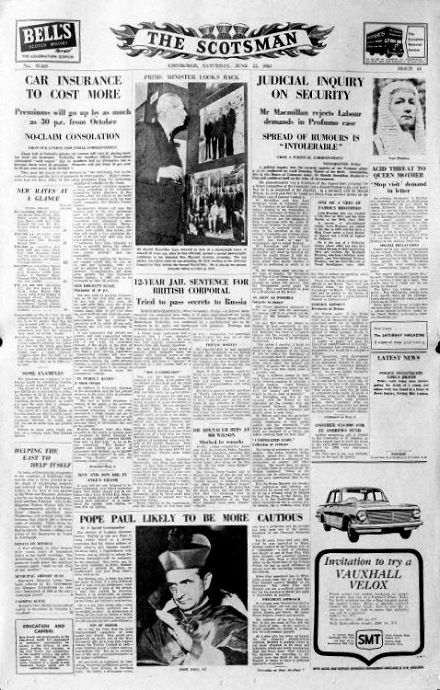
THE DECLINE OF Scotland’s nation newspaper is marked and lamentable. Once exhibiting a certain grace and dignity, the Scotsman was the most respected of Caledonian dailies. It was the only to have bureaus overseas, and it presided as king of the newspaper realm from stately offices on the heights of North Bridge. All of that, of course, is all gone. It’s all about cost-cutting and driving up circulation instead of maintaining the role as Scotland’s newspaper of record. (more…)
Nederlands Dagblad
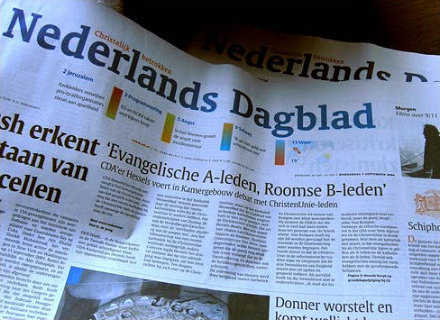
ONE ENVIES the Dutch for having a quality, serious Christian daily newspaper, Nederlands Dagblad (“Netherlands Daily”), even if it is Protestant-run and -oriented. A daily newspaper since 1967, ND currently has a circulation of 33,000. The circulation has been increasing in the past few years, reportedly among non-Christians who desire an alternative perspective from that of the mainstream newspapers. Could not the same be replicated in America, perhaps even on a Catholic basis?
The Auld Scotsman
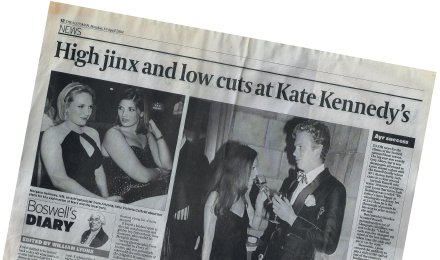
ONE THING WE greatly enjoyed about the Scotsman in its pre-tabloid days was that they often deemed St Andrews social events worthy of coverage in their august pages. It was a source of pride to see ‘the national newspaper’, a respectable broadsheet, covering events at the oldest university in the land (which we are proud to call our own). Naturally, once the conversion to tabloid size was complete, we were rarely heard of again, which was a little saddening. The Scotsman is not what it used to be —a beautiful, well-designed, informative respectable newspaper— but it still manages to print some thoroughly worthwhile articles which is more than can be said of any other Scottish daily. (One need only point out two articles by Prof. Haldane, c.f. here and here, recently posted on this site).
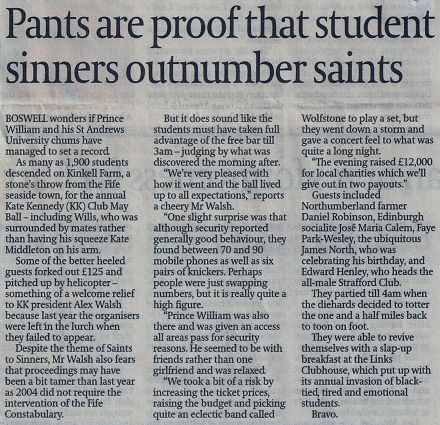
“…when the diehards decided to totter the one and a half miles back to toon on foot.” Sounds familiar.
Admittedly, most of the events covered were organised by the Kate Kennedy Club, which seems to take pride in the sheer vulgarity and tastelessness with which they advertise many of their events. (This is only slightly mitigated by their superb running of the annual Kate Kennedy Procession). Still, we enjoyed the Scotsman‘s coverage and wish it had continued. I only bought the Scotsman on occasion after the switch, but often gave the Common Room’s copy a browse when I lived in St. Salvator’s. (Its Sunday edition, Scotland on Sunday is worth buying for Gerald Warner alone).
Here are a few bits and pieces clipped from the Scotsman for your perusal:
‘Undampened spirits take the party indoors‘ / Lumsden Club garden party moved indoors on account of the rain. (I didn’t go).
‘High jinks and low cuts at Kate Kennedy’s‘ / This covered the Kate Kennedy Procession dinner which takes place at the Old Course Hotel on the evening following the procession. This particular year I was in attendance myself and recall commiserating with Michelle Romero, that charming daughter of Venezuela, about the troubled state of her native land. I was their with our favorite Dane, Sofie von Hauch, and my flatmate, a member of the KK who wishes to remain unnamed on this site. Will Lyons couldn’t make the dinner himself, so he sent ‘K‘ up instead, accompanied by ‘society photographer Z‘ whom I ran into while we were on our way out.
‘Maltesers set ball rolling for charity‘ / The 2004 Knights of Malta Ball, not covered by this website because it did not exist at the time. It was a good time, especially so because I had three friends over from the States. Yalie Adam Brenner was doing his semester abroad at St Andrews at the time, and fellow Old Thorntonian Clara de Soto popped over from Boston College for the weekend with her good friend Katie Cordtz of Atlanta. The four of us together with Michelle Romero and the aforementioned unnamed flatmate of mine piled into a cab and made the hour’s journey to Edinburgh for the soirée. Poor Adam, though. Towards the latter part of the evening Archie Crichton-Stuart, an exceptionally amusing Edinburgh student, and his friend Ramsay forced Adam to consume the significant remnants of a bottle of house red. It all went down swimmingly, but came back up on the cab ride back to Fife. Freddy McNair, who was recently nearly killed by an incompetent gurkha on a training ground, sat at the table next to ours, I recall. (Also, in the lower right-hand corner of the clipping you can spy the face of our good friend Ricky Demarco peering out from an unrelated article).
Previously: Another Broadsheet Bites the Dust
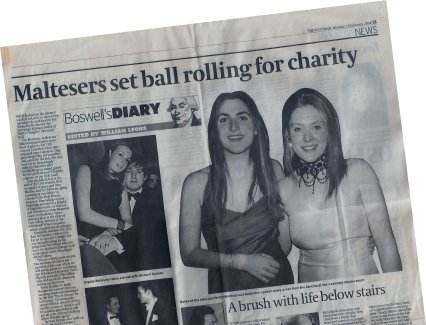
Racialist Thinking Behind the Times
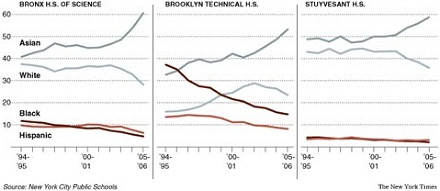
The fair-minded, independent observer would look at the figures above and think to himself “Interesting, the proportion of Asian students is on the rise, while that of White, Black, and Hispanic students is generally in decline”. However the racialists (I will not use the more loaded term of ‘racist’, though the meaning is exactly the same) at the New York Times can only see the Black and Hispanic decline, captioning the chart ‘The share of black and Hispanic students New York City’s three most elite specialized schools has declined’.
And why no chart depicting the racial make-up of the also public selective Hunter College High School? Is it, by some unknown criterion, not in the same league or perhaps the proportion of black and Hispanic students there actually rose? The Times reader is left uninformed as to the greater picture, but suitably inculcated in racialist thinking.
Gothamist’s Jen Chung notes the decline is “in spite of the city’s best efforts to encourage [Black and Hispanic students] to apply and attend” while City Councilman Robert Jackson ponders “”Is it institutional racism or is it something else?”.
Could it perhaps be that the racial makeup of the city’s elite public high schools is subject to (quel horreur!) occasional fluctuations? What is the racial makeup of an elite public high school “supposed” to be? Here’s a concept worth considering: how about giving the students in selective public high schools the best education on offer and admit students based purely on a meritocratic standard which does not descriminate by sex, race, class, or creed? Just a thought.
Can Kid Save This Sinking Ship?
25-Year-Old Buys the Salmon Siren of the Upper East Side
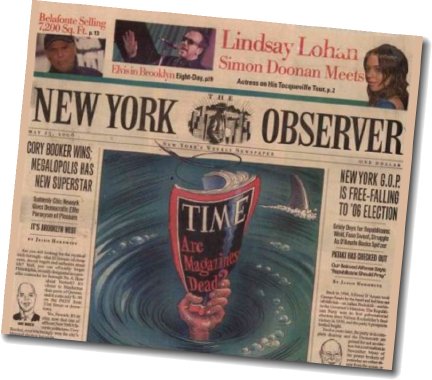
AN NYU LAW  student of just twenty-five years of age has purchased the majority stake in the New York Observer. Jared Kushner (right), son of the currently jailed big-time donor to the New Jersey Democrats Charles Kushner, bought the biggest-piece-of-the-pie off of publisher Arthur Carter, who founded the insouciant weekly printed on salmon-tinted paper back in 1988. No official word on how much money changed hands during the deal, though the Times cites “one person familiar with details of the sale” claiming the amount was nearly $10 million. Carter will maintain a significant say in the paper’s operations, and there are no plans to make any changes to the masthead as of the moment. Earlier in the year Robert de Niro was in talks to buy the Observer through his Tribeca Film Festival operation, but the negotiations fell through.
student of just twenty-five years of age has purchased the majority stake in the New York Observer. Jared Kushner (right), son of the currently jailed big-time donor to the New Jersey Democrats Charles Kushner, bought the biggest-piece-of-the-pie off of publisher Arthur Carter, who founded the insouciant weekly printed on salmon-tinted paper back in 1988. No official word on how much money changed hands during the deal, though the Times cites “one person familiar with details of the sale” claiming the amount was nearly $10 million. Carter will maintain a significant say in the paper’s operations, and there are no plans to make any changes to the masthead as of the moment. Earlier in the year Robert de Niro was in talks to buy the Observer through his Tribeca Film Festival operation, but the negotiations fell through.
The Observer, with a small-but-influential circulation of 55,000, has undergone a miniature transformation recently with the hopes of turning around the current losses of about $2 million a year. The most noticeable of these changes came in May when the paper trimmed over an inch in width, moving from six front-page columns to five and giving it a taller, more narrow appearance. While the thinner size saves on rising newsprint costs it also means diminished space for advertising, and the newspaper lost its easy, leisurely feel, also moving from two sections to one. The Observer has also increased the volume of its internet operations on Observer.com, some might say at the expense of the quality of the printed edition. The new owner, however, will take a back seat in the content of the newspaper while concentrating on improving the bottom line, citing the Observer‘s strong brand despite its current financial woes.
Kushner’s father, a well-known New Jersey real estate developer, was sentenced to a jail term last year after being found guilty of tax evasion, and is well-known for a number of other stunts which do not bear repeating on, er, family-friendly sites such as this. The younger Kushner himself has given over $100,000 to various (Democratic) political outfits since 1992, when he was a mere eleven years of age.
I used to read the Observer often (though not regularly) because it had the most style of all the New York newspapers. While its flighty spirit meant it lacked a certain depth, it still had zing and usually at least a handful of interesting articles each week. The quality of the content began slipping, however, and when I came home to New York I bought one copy while waiting for the train in Grand Central, was completely dissatisfied like the new size and feel, and decided to give it up. I will always have a certain fondness for the Observer though; in the age when Gannett-style corporate monotony is king, it has managed to maintain a certain classic swankiness (epitomised in its reporter-and-skyline emblem) and for that we can be grateful.
Dawn Eden in the Irish Times

This morning I was browsing the front pages of a few of the world’s leading dailies and came across the Irish Times. I thought to myself “My, that lady bears a striking resemblence to Dawn Eden.” Then I read the headline ‘Chastity Can Make You Happier, Says Author’ and thought to myself “How bizarre! That sounds just like something Dawn would say.” Finally I put two and two together and thought “Crikey! That is Dawn!” C.f. the Dawn Patrol.
Our readers will no doubt recall that Dawn mentioned my comments regarding the Brooklyn Museum’s mauling of their own façade in her Daily News column. More recently she’s written a book and has been buying refrigerators for nuns.
Elsewhere: Superpower: The View from New York – Matt Alderman reports on a night on the town with Dawn Eden including the ever-prescient and incisive wisdom of Andrew Cusack
The Sad State of the Modern Newspaper
…and the heroism of an Anglo-Hungarian countess.
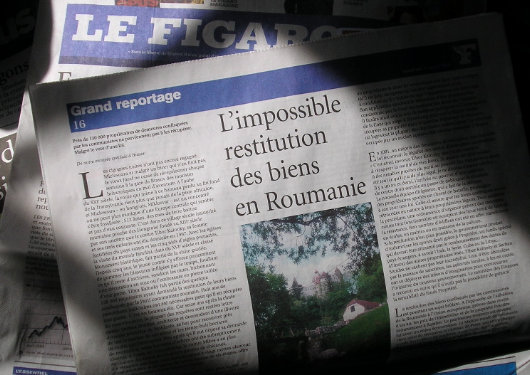
IT IS ONE OF THE more saddening facts of life that British newspapers have suffered an inexorable decline in the past few years. The great Times of London – once the most respected newspaper in the world – has been reduced to a boring mid-brow tabloid, the once-solid Scotsman idiotified and, again, tabloided, and of course the Daily Telegraph, which has gone from staunchly conservative (as in worldview) to merely Conservative (as in the tribe of Britons who prefer blue to red).
The Telegraph, like the Conservative party itself, doesn’t seem to know what it’s there for. It has at least remained a broadsheet; going tabloid would be a disaster and would probably be considered the last straw for all the die-hards for whom loyalty to one’s newspaper is a point of pride. And, to its credit, it finally seems to have realised the damage done by constant front-page photos of “Posh” and “Becks” and other “celebrity” partisans of the Anti-Culture, for they seem fewer and far between these days (as compared to a year or two ago, when they were frequent). The Telegraph‘s base are old folk who want a quality newspaper. They are loyal to the Tele and, despite its decline, would be too embarrassed to jump ship to the Guardian, which is written better but which nonetheless expones a nefarious ideology.
As for myself, the last straw came one morning in the Common Room of St. Salvator’s Hall when, flipping through the Telegraph, I reached the page which normally displays the Court Circular but found it missing, replaced by a curt statement advising that should I desire information about the activities of the Royal Family I should direct myself to http://www.royal.gov.uk. Outrageous! As it happens, this is not a permanent loss but rather an occasional one, as the editors at the Telegraph seem to decide whether or not to print the Court Circular each day on a whim. Fair enough, but I came to the realisation that the producers of the Telegraph are not aiming at me – the reasonably educated young man who seeks in his daily read a newspaper that is well-written, right-thinking, and properly presented – and so I have ceased to be a Telegraph regular.
What to read then? We have already dismissed the Times, the Scotsman, and the Guardian. The Daily Mail is always readable but arguably aimed at a different demographic; the Daily Mirror, bonkers; the Sun, no thank you!; the Financial Times is too boring, though the Weekend edition is actually worth buying most of the time; the Independent has a good layout for a tabloid, but is rather of a Lib-Dem persuasion; the Glasgow Herald is just rather dull and has only recently repented of its long-held anti-Catholicism. Not wanting to support the nefarious New York Times, enemy of Western civilization and the last word in liberal elitism, its wholly-owned subsidiary the International Herald-Tribune is ruled out. Which pretty much rules out every English language daily newspaper available in St Andrews.
 So, abandonné par ma langue, I have outsourced my daily read to the Continent (of all places!) and am now a partisan of Le Figaro. While by no means fluent in the language, I can comprehend written French with greater ability than I speak it. And while I still prefer the feel of a broadsheet, the Berliner size of Le Figaro has its advantages, being very easy to read in the confined space of my regular chair in the corner of the little coffee shop down the street. More importantly, I find it much more engaging mentally, which I put down to the fact that (not being a native or fluent French speaker) I am forced to read every word. Reading the Telegraph one unthinkingly only actually reads every third or so word; articles of particular interest excepted, naturally. The day’s Figaro usually arrives in the middle of the day or the afternoon, but I buy my paper in the morning so actually I’m usually reading the previous day’s Figaro. I don’t mind, it suits my current routine. (Mornings are for reading the newspaper in a coffee shop, afternoons are for reading books with a slow pint in the pub.)
So, abandonné par ma langue, I have outsourced my daily read to the Continent (of all places!) and am now a partisan of Le Figaro. While by no means fluent in the language, I can comprehend written French with greater ability than I speak it. And while I still prefer the feel of a broadsheet, the Berliner size of Le Figaro has its advantages, being very easy to read in the confined space of my regular chair in the corner of the little coffee shop down the street. More importantly, I find it much more engaging mentally, which I put down to the fact that (not being a native or fluent French speaker) I am forced to read every word. Reading the Telegraph one unthinkingly only actually reads every third or so word; articles of particular interest excepted, naturally. The day’s Figaro usually arrives in the middle of the day or the afternoon, but I buy my paper in the morning so actually I’m usually reading the previous day’s Figaro. I don’t mind, it suits my current routine. (Mornings are for reading the newspaper in a coffee shop, afternoons are for reading books with a slow pint in the pub.)
The chief deficit of reading a French newspaper is that naturally the news is oriented towards France, and thus I don’t get the usual transatlantic focus of the British papers (which can be an advantage as well as a deficit, I’ll concede). Nonetheless, it does happen to have articles of interest to any trad.
A few weeks ago, Le Figaro reported on the restitution of Romanian castles to their original, pre-Communist owners (‘L’impossible restitution des biens en Roumanie’, Le Figaro, 21 April 2006). The New York Sun rather amusingly and provincially headlined the story “Westchester Man To Take Possesion of Dracula’s Castle” — the New York Post characteristically used the headline “VLAD TIDINGS“. (FTD also reported on the restitution of Bran). When I wrote my previous post on the subject I was under the impression that Bran was one of the castles which would be restituted and then purchased back by the Romanian government, but most sources imply that this is not the case and Dominic von Habsburg (of North Salem, New York) will actually take possesion of the castle, I’m glad to hear.
This morning, then, I read in Le Figaro of the controversy surrounding a red star which remains on a Soviet war memorial in a small town in Hungary, a country which has banned all Communist and Nazi emblems (‘Hongrie: Le pasteur, la comtesse et l’étoile rouge’, Le Figaro, 6 May 2006). The local Protestant minister has been fighting to replace the red star, and has found an ally in Countess Jeanne-Marie Wenckheim-Dickens. The Countess, aged 70 and a descendant of Charles Dickens, returned to Hungary a few years ago after her husband died. The family had fled the country in 1944 just escaping the conquering Red Army. “I return home,” the Countess says (‘with a delicious British accent’, Le Figaro reports), “and what do I find? My castle transformed into an elementary school with, right in front of the gate, a red star! To me, this star is the Antichrist.”
The Countess funded the restoration of her former castle, now a school, and obtained permission from the town to live in the old presbytery, an ancillary building of the old castle. But when, in 2004, she proposed to mark the accession of Hungary to the European Union by replacing the red star on the monument with a European flag, the ex-Communists in the town hall told her she “should not be afraid of the red star, but of the Cross!” With fighting spirit, “I placed a large cross on my entryway,” the Countess says, “then I painted it gold so that the Mayor, whose window is opposite, can see it all the better.”
“Crosses? She can build a hundred of them!” the Mayor said. “It doesn’t disturb me!” But in return the Mayor had a house on what was the domain of the Wenckheim family renovated for the use of unemployed local gypsies. “It was clearly to annoy me,” the Countess said. “They thought the gypsies were going to make the area around the nearby church, built by my grandfather, filthy. But not at all! They respect the place, and I, I love their music very much.” The Countess also gives weekly catechism lessons to the local gypsies. In her window, she displays a letter to the people of the town inviting them to vote for the conservative Fidesz party. “In December,” the Countess continues, “before Christmas, I add little angels and holy pictures; they don’t like that much across the way, since they’re aimed at the town hall. Because I, too, have a star: but is the star of the Shepherd”.
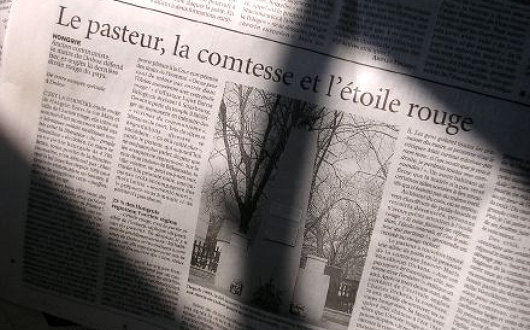
Grande Journalerie
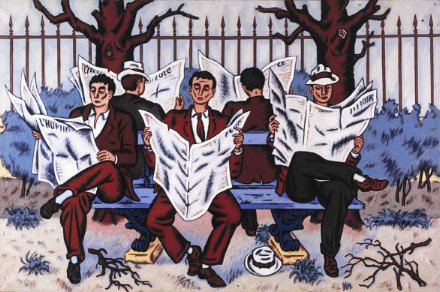
Jean Hélion, Grande Journalerie
Oil on canvas, 51″ x 76″
Robert Miller Gallery, New York
A Bit of Sun
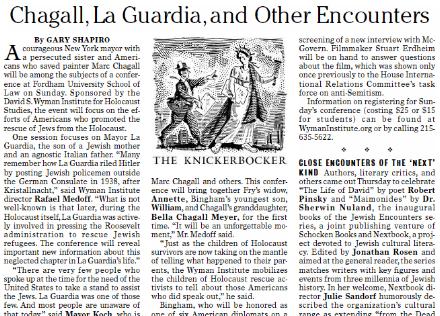

My ownly major aesthetic gripe against the Sun is the layout of the front page of their Friday second section, currently titled ‘Arts+’. (The ‘plus’ presumably refers to the inclusion of the Sports pages towards the end). Below at left is Section II as it appeared in the September 2-4 edition. The sans-serif font is just a tad too Gannett for a publication as esteemed as the Sun. To the right and below it I have placed two proposals for a reform of the Section II front page, both of which, I believe, are much more in keeping with the general aesthetic and demeanor of the rest of the New York Sun.
The Church in China
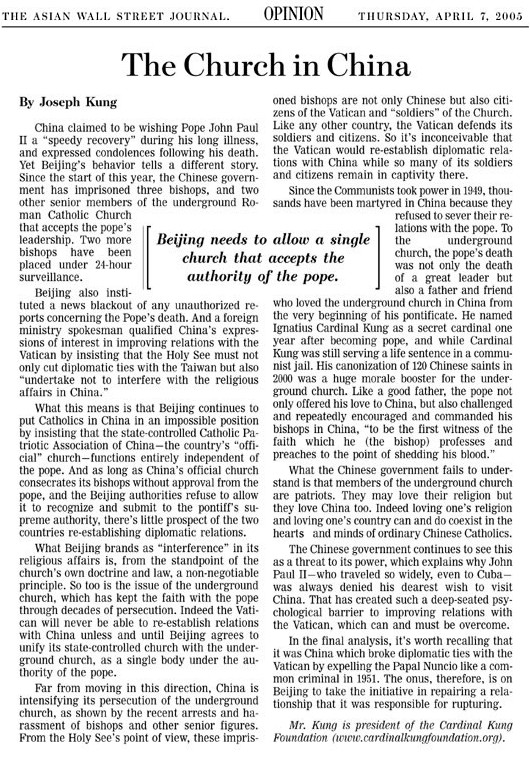
C.f. the Cardinal Kung Foundation.
‘Mitre Schmitre’: A Brief Dissection
Nothing is quite as much fun as a good old debate in the press. Alas, the Saint, true to form, published a somewhat slapdash and second-rate response (see post below) to what I thought was a pretty decent, albeit somewhat light-hearted, attack (see the Mitre, February 15, 2005, pp. 1-3). Well, herein follows a very brief highlight of portions of Mr. Hendele’s retort.
“Most of you probably haven’t read it – or heard of it – but what is important is that it continues to provide students with a voice.”
Judging from the usual content of the Saint, we should very much hope that their target audience has not heard of us, let alone read us. We are a quality newspaper, we are not a tool for entertaining the masses.
“What is important is that it continues to provide fair and unbiased coverage of things which matter most to students.”
Here, I must report an innacuracy. Though the Mitre is fair, we are far from unbiased. In fact, I am happy to report we have all the best biases.
“In a ‘recently’ – it only comes out once a month – published editorial from the Mitre of February of this year, the paper claimed The Saint has adopted a patronising, smug tone toward Christians, evangelicals and Catholics, and that this is indicative of our ‘intellectual backwardness.’ First of all, I do not see how one’s tone can be construed as an indicator of their intellect.”
I would advise the author to keep trying; perhaps someday he will gain just such an ability.
“Further, all of the articles written about Christians this year were authored by a Catholic, me, and have been aimed at the bigots who travelled great distances in an attempt to silence students’ in their exercise of the inalienable right to expression.”
Oh, the author is Catholic! Always good to have a fellow Catholic in the student press. Strange that he would defend a supremely blasphemous and perverted play as the ‘exercise of the inalienable right to expression’, but at least the author is Catholic, right?
“Secondly, how dare a paper so obviously enamored with the intricacies of Mother Church and the brainwashing dogma prescribed by it attack The Saint for being intellectually backward.”
Wait, I thought he said he was Catholic? Labelling the dogma proclaimed by Christ’s Church as “brainwashing” and insinuating that Catholicism (which I’m sure the author will recall is responsible for the preservation and maintanence of Western civilization not to mention the foundation of the University of St Andrews and every medieval university in Europe) is actually “intellectually backward” are not things that Catholics are wont to do. Perhaps the author meant to write “former Catholic” or “ex-Catholic” or the trendy “recovering Catholic” or the slightly more neutral “was raised Catholic” which would imply the disassociation from the Church so blatant in the author’s tone.
I also, perchance, wonder what Augustine and Aquinas would think when, upon reading the Saint, they discovered – quel horreur! – that James Hendele has implied that is they, the members of the greatest intellectual tradition the world has ever known, who are intellectually backward, instead of the mindless drones who regurgitate the spirit of the age fed up by the Guardian, New Statesman and other outlets of the secularist media and culture.
“Furthermore, the only other articles written about the University’s Christians this year have been in regards to their annoying, yet undeniably plucky, insistence on inviting ‘academics’ to speak on the merits of creationism.”
First Mr. Hendele said he wrote all the articles about Christians this year, now he says that there are others. Besides, we did not attack the Saint for having a smug and patronising tone for just this year; it has existed longer than that.
“The Saint has asked the Christian Union in a number of instances to contribute pieces reflecting their stances on issues of national importance and has not once heard a reply. Pot + Kettle = Black, you do the math.”
The Mitre is in absolutely no way associated with the (evangelical) Christian Union and never shall. The Christian Union often propagates the opposite strain of anti-intellectualism to that exhibited in the Saint.
“In that same article of February of this year, the Mitre not only goes on to quote our current, supremely ineffectual and apathetic rector, as saying that he believes The Saint has let its standards slip, but also accuses the paper of printing an excess of copies in order to somehow defraud would-be advertisers out of money. Any article based on the words of Clement Freud, a man more concerned with the sound of his own voice, should be taken with a pinch of salt. His recent contradictory statements on the problems The Saint were facing is testament to that. Furthermore, I do not see how printing extra copies and not selling them would in any way entice businesses to advertise. In fact the reason we print so many copies is because we must print a minimum of 1,000 and every thousand copies above that number costs only £3. It would do the Mitre well to get its facts straight before it starts pointing fingers at out ‘faulty accountants.'”
The remarks against Clement Freud are not worth refuting. Putting quotation marks around “faulty accountants” in my mind implies that such was a term used in either the Mitre article or commentary piece. In fact, the phrase is in neither the article nor the opinion piece. A tad misleading, but easily forgiven.
Mitre Schmitre
The Uni’s other newspaper ought to get its facts straight
(Published in the Saint, Thursday 5 May 2005)
by JAMES HENDELE
Here’s something I bet you didn’t know: our university has not only one, but two student newspapers. Well, more like one student newspaper and one student evangelical handout. Now I am not one to lambaste members of my own literary community, to accuse and name call and slander those I consider my fellow scholars and thinkers and journalists. I admire their effort. To start a student newspaper from scrap and turn it into a publication that can rightfully claim to be St Andrews’ most religious monthly takes determination, smarts and a dose of class.
Most of you probably haven’t read it – or heard of it – but what is important is that it continues to provide students with a voice. A voice which can be heard all the way from North Street in the north to South Street in the south. What is important is that it continues to provide fair and unbiased coverage of things which matter most to students: the latest Vatican news, the status of the recently formed St Andrews pro-life society, a definitive guide to the town’s best martini, and in depth coverage of Pope-watch ‘05. What is important is that it continues to assail those who would hinder students in their quest to know the specific details of last week’s debate. Here here, Mitre, here here.
I do not really think that anyone could possibly argue that this town is too small for two papers or that it is too liberal for a conservative voice. Quite the contrary – this student body has long been in need of a paper dedicated to voicing the concerns of those among us with a political or religious persuasion which would cause them to vote Tory and rest on the Sabbath. What bothers me is the way in which this University’s second paper has, at many instances, rebuked the editorial team of The Saint when it is guilty of the same sins it claims to reject.
In a “recently” – it only comes out once a month – published editorial from the Mitre of February of this year, the paper claimed The Saint has adopted a patronising, smug tone toward Christians, evangelicals and Catholics, and that this is indicative of our “intellectual backwardness.” First of all, I do not see how one’s tone can be construed as an indicator of their intellect. Further, all of the articles written about Christians this year were authored by a Catholic, me, and have been aimed at the bigots who travelled great distances in an attempt to silence students’ in their exercise of the inalienable right to expression. Secondly, how dare a paper so obviously enamored with the intricacies of Mother Church and the brainwashing dogma prescribed by it attack The Saint for being intellectually backward. Furthermore, the only other articles written about the University’s Christians this year have been in regards to their annoying, yet undeniably plucky, insistence on inviting “academics” to speak on the merits of creationism. The Saint has asked the Christian Union in a number of instances to contribute pieces reflecting their stances on issues of national importance and has not once heard a reply. Pot + Kettle = Black, you do the math.
In that same article of February of this year, the Mitre not only goes on to quote our current, supremely ineffectual and apathetic rector, as saying that he believes The Saint has let its standards slip, but also accuses the paper of printing an excess of copies in order to somehow defraud would-be advertisers out of money. Any article based on the words of Clement Freud, a man more concerned with the sound of his own voice, should be taken with a pinch of salt. His recent contradictory statements on the problems The Saint were facing is testament to that. Furthermore, I do not see how printing extra copies and not selling them would in any way entice businesses to advertise. In fact the reason we print so many copies is because we must print a minimum of 1,000 and every thousand copies above that number costs only £3. It would do the Mitre well to get its facts straight before it starts pointing fingers at our “faulty accountants.”
(Transcribed as printed).
Which Way Forward for the Sun?
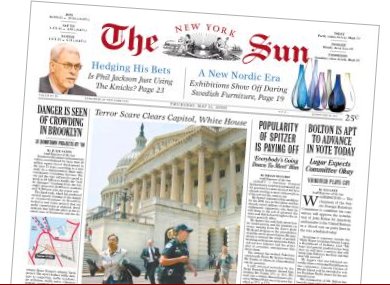
Marty Browne, a loyal reader from Queens, has brought to my attention that a hooplah has taken place in a few media outlets recently concerning our beloved New York Sun. Essentially, two memos written by Robert Messenger, deputy managing editor of the Sun, were somehow leaked to Gawker, Gotham’s flitty rumor mill, and posted on May 11, 2005.
 The two memos deal with the state of the Sun at the moment and highlights some concerns over its long-term future, suggesting something of a ‘back to basics’ course for the three-year old conservative broadsheet. Our friend Mr. Browne was concerned enough to write a letter to the editor cautioning against changing our beloved Sun, bar adding a few more voices from the old right (advice which should be heeded). But having read the memo, I think it offers a frank analysis of the paper today and productive suggestions for the direction it should go in.
The two memos deal with the state of the Sun at the moment and highlights some concerns over its long-term future, suggesting something of a ‘back to basics’ course for the three-year old conservative broadsheet. Our friend Mr. Browne was concerned enough to write a letter to the editor cautioning against changing our beloved Sun, bar adding a few more voices from the old right (advice which should be heeded). But having read the memo, I think it offers a frank analysis of the paper today and productive suggestions for the direction it should go in.
Essentially, what the Sun has to do is decide what it will be. It would be excellent if New York could have a general interest conservative broadsheet newspaper. However, given the overwhelmingly liberal market, I doubt the city’s ability to support such an endeavour; a luxury we sadly cannot afford.
In the mad media market of Manhattan, the most reliable option for the Sun is not as a general interest paper, a more financially-precarious model, but instead to find a niche in which to solidly rest. The weekly New York Observer, only born in the nineties, has a niche which gives it a fairly firm foundation provided it continues to serve it well, and the Sun should take note of that.
Thus the niche market is the way to go. What niche though? In my opinion, the New York Sun should be three things: 1) Conservative, 2) High-brow, 3) Metropolitan.
1) The Conservative Newspaper: The right-minded mustn’t just give up and concede New York as legitimately 100% liberal. This simply would not reflect reality, and the Sun must continue to provide a conservative voice on a higher scale than the populist New York Post.
2) The High-Brow Newspaper: Arts & Letters is already the most flourishing section and long may it continue. James Gardner on great on Architecture and I am absolutely loyal to the architectural historian Francis Morrone’s ‘Abroad in New York’ column every Monday. The Editorial and Opinion sections provide good sound argument and discussion, but could do with expansion.
3) The Metropolitan Newspaper: Of course it must continue to be an intrinsically New York paper. Coverage of the civic, political, and social sides of the city are essentially. This department has been pretty solid and consistent, and should only be augmented.
Should the New York Sun aim to be the conservative, high-brow, metropolitan newspaper, I believe it will be a winning formula, and set the newspaper well along on path towards becoming a great New York institution, if it isn’t one already.
(Continue reading for my thoughts on a few of Mr. Messenger’s points.)
Taki on the Sun

In this week’s Spectator, the ‘poor little Greek boy’ Taki informs us of a feud between the Dorothy Parker Society and the F. Scott Fitzgerald Society. Apparently the DPS invited the FSFS to a big to-do at the Algonquin and the FSFS didn’t even respond. “I get all this info from my favourite Big Bagel paper, the Sun, or the Sharon, as I call it, because of the line it follows where Israel is concerned.” I love the Sun, and I’m very glad Taki has discovered our favorite New York daily. He continues:
Benchley, like Parker, was a founding member of the Algonquin round table, and was known to have spilled more booze than F. Scott ever downed. Unlike the latter, he could hold it. Emerging once from the Waldorf Astoria, he commanded a doorman to get him a taxi. ‘How dare you, Sir,’ came the answer. ‘I am a United States admiral.’ ‘Well, in that case,’ said the well-oiled Benchley, ‘get me a battleship.’
Moving along…
I have not read his book, which is coming out sometime next year, but press reports have it that he was delighted by what he discovered. His accounts apparently have no condescending references to the kitsch or to materialism, which so many of us Europeans refer to every time we write about or mention America. That’s because he went to places like Cooperstown, New York, where the baseball hall of fame museum is located, or to Pennsylvania, among the Amish. (Not much materialism among that lot, that’s for sure.) And a poignant moment, when he is accosted by a Michigan policeman and told to stop loitering and to keep moving — BHL is relieving himself in a field — and he informs the cop that he’s a Frenchman and that he’s following Tocqueville’s footsteps, which results in a pleasant conversation.
Yes, Americans are nice people who want to be nice and do not understand why the Europeans hate them so. Our own Paul Johnson explained it all some weeks ago when he said that, if he were younger, he’d move to the land of plenty. Sure, manners are not an American strong point, nor is its taste for music and movies. But the natives are friendly, vulgar and nice, which is a lot more than I can say for some of us from the old continent.
I seem to have misplaced or thrown out (shudder!) the Speccie with Paul Johnson’s salient words urging and young people with talent in Britain to move to America, but if I do find it, I shall post his words of hope.
The Rites of Saturday Morning
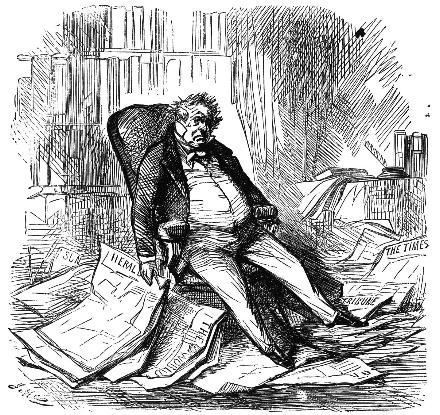
ORDER OF SERVICE
Entrance (silence)
(The officiant then organises the various sections of newspaper into the order in which they shall be read. Frivolities, such as ‘Gardening’, ‘Motoring’, and ‘Money & Business’, are discarded.)
First Reading: The Daily Telegraph, first section
Second Reading: The Financial Times, first section
First Glance: The Daily Telegraph, Weekend section (Rarely anything worth reading inside, but tradition requires at least a glance)
Third Reading: The Daily Telegraph, Property section
Nourishment: A sugar doughring from Fisher & Donaldson’s (Members of all newspaper-reading denominations are invited to partake, but are encouraged to abide by the rules of their respective communities)
Fourth Reading: The Financial Times, Weekend section (The best weekend section there is. Short and varied.)
Second Glance: The Daily Telegraph, Travel section (Ditto notes on Telegraph Weekend section)
Fifth Reading: FT Magazine
Final flip through the pages: (ruffle, ruffle, ruffle)
Exit. (The assembled then disperse and carry on with their day).
Warner on the Gotha
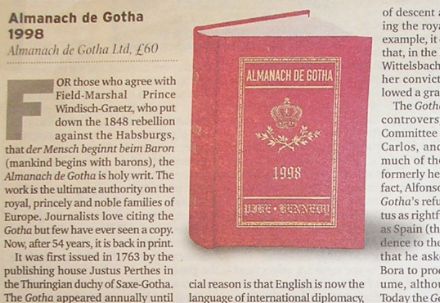
Whilst rummaging through my room at home in New York last week, I came across this article which I had cut out of the ill-fated European in 1998 written by none other than Mr. Gerald Warner, KM. I was fourteen years old in 1998 and the European folded about a year later. Click here to read in jpg form. (A large file, some browsers may require resizing to view the text at a readable size).
Search
Instagram: @andcusack
Click here for my Instagram photos.Most Recent Posts
- Telephone Kiosk No. 2 May 15, 2024
- The last of its vintage May 15, 2024
- Letters Patent May 8, 2024
- Bicycle Rack April 29, 2024
- Burns Tower April 19, 2024
Most Recent Comments
Book Wishlist
Monthly Archives
Categories

